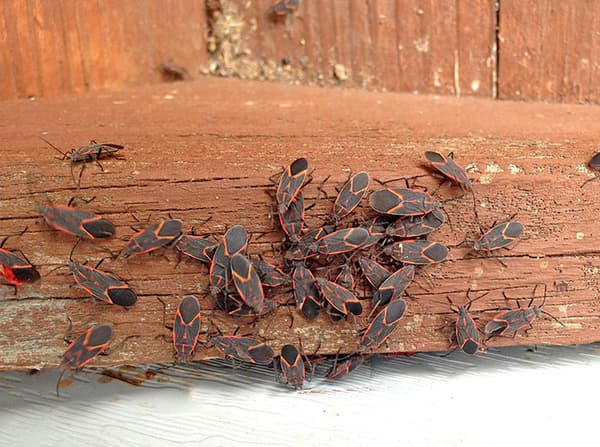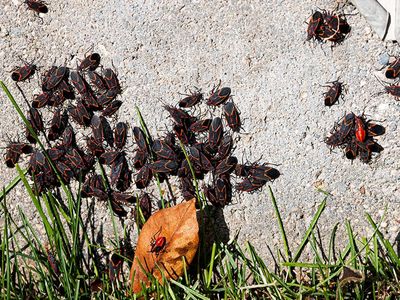What do boxelder bugs look like?
Boxelder bugs are easy to spot thanks to their distinct appearance. They’re mostly black with bright orange-red markings along their edges, giving them a bold, eye-catching look. These insects have an almond-shaped body and tend to gather in groups, especially when you see both adults and young ones—called nymphs—together.
Nymphs don’t start off with the black coloration. Instead, they’re smaller and mostly red, which can lead to some confusion. People sometimes mistake them for mites or chiggers, but a closer look reveals key differences. Mites and chiggers are much tinier and have eight legs, while boxelder bugs, being true insects, have six.
Boxelder bugs go through three life stages: egg, nymph, and adult. Fully grown adults reach about half an inch in length, while the nymphs are considerably smaller during their early development.

Do boxelder bugs bite?
Technically, boxelder bugs can bite—but it's pretty rare. When they do, it’s not dangerous, just a bit irritating. A bite from a boxelder bug might look and feel a lot like a mosquito bite: some mild swelling, a bit of redness or a rash, warmth around the area, and that familiar itch. If you happen to get nipped, just wash the spot with soap and water, then use a cold compress to help ease the discomfort.
Are boxelder bugs harmful?
For the most part, boxelder bugs are considered nuisance pests. They rarely bite, and they don’t usually cause significant harm to plants. Still, they can create a few problems that are worth knowing about.
Boxelder bugs feed on the developing seeds of boxelder, maple, and ash trees, which can lead to yellowing leaves. They also occasionally feed on certain fruits, potentially damaging the produce. Indoors, they become more of a headache. When squished, they release an unpleasant odor. And if they make their way inside your home or business, they can stain light-colored surfaces and fabrics with their droppings.
Most of the time, customers reach out to us simply because these bugs gather in large numbers, become an eyesore on siding or windows, or start sneaking indoors and overstaying their welcome.
When are boxelder bugs most active in Pennsylvania?
In Pennsylvania, boxelder bugs are most active during the fall and spring. Here's a quick breakdown:
Fall: This is when they become very noticeable. As temperatures drop, boxelder bugs gather on the sunny sides of buildings and start trying to move indoors to find a warm place to spend the winter.
Spring: When the weather warms up, they become active again as they leave their overwintering spots and head outside to feed and reproduce.
They're also somewhat active during warm winter days. If they’ve gotten into your home, they’ll emerge from hiding places like wall voids or attics, looking for warmth and light.
Why do I have boxelder bugs in my home?
If you have boxelder bugs in your home, it's likely because they’re seeking warmth as the weather cools in the fall. As the temperature drops, they look for sheltered spots to overwinter, and your home offers the perfect place. They often gather on the sunny sides of buildings, and if they find cracks or gaps around windows, doors, or vents, they can easily slip inside.
Once the weather warms up in spring, they wake from their hiding spots and may be seen inside before heading back outdoors. You may see them looking for a way outside.
Are boxelder bugs active during winter?
Even though they may gather inside your home to escape the cold, they go into a sort of dormant state (called diapause) and aren't interested in feeding or mating. They don’t lay eggs or build nests indoors—so while they can be a nuisance if they get inside, they’re not multiplying while they're there.
How do you get rid of boxelder bugs?
Evergreen Pest Solutions, a local Pennsylvania pest control company, offers effective pest control services that address boxelder bugs and other house-infesting insects and rodents in Scranton, Wilkes-Barre, and surrounding communities.
Can I keep boxelder bugs out of my home?
A little prevention can go a long way. If you’re already seeing boxelder bugs inside, start by vacuuming them up and tossing the vacuum bag into an outdoor trash bin. From there, it’s all about sealing up your home to stop them from coming back.
Here’s where to look:
- Pipes and utility lines: Check where wires, cables, or plumbing enter your home and seal up any gaps with expanding foam.
- Foundation cracks: Use mortar or foam to close off cracks or gaps near the base of your home.
- Exterior doors: Look for light shining through—if you see it, so can bugs. Replace worn weatherstripping and realign double doors if needed.
- Windows and door frames: Use caulk to seal up any cracks or gaps around the trim.
- Window screens: Patch up any holes or tears to prevent bugs from sneaking in through open windows.
Once your home is sealed up—or even before you get started—consider calling in a pest control company like Evergreen Pest Solutions. Our team can inspect your home, reinforce vulnerable spots with exclusion materials, and apply targeted treatments to help keep boxelder bugs (and other pests) from finding a way in.
We offer one-time fall treatments or year-round pest management plans, depending on what works best for your home. And while boxelder bugs are mostly a nuisance, the steps you take to block them out will help keep more serious pests away, too.








